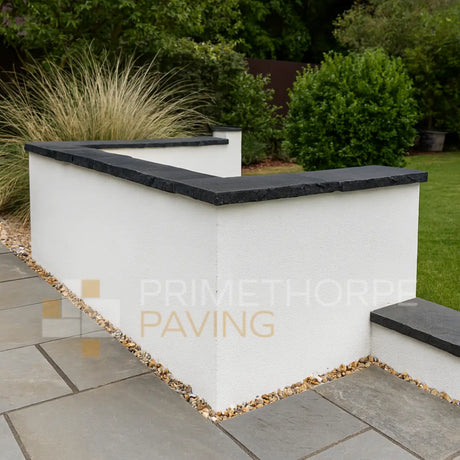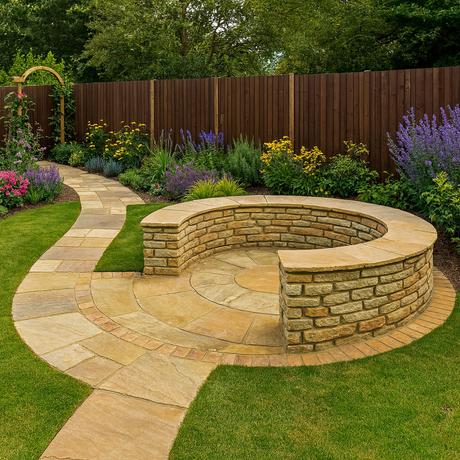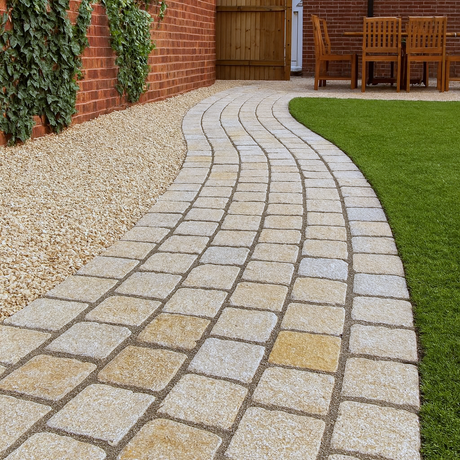Our in-house experts at Primethorpe have been thinking about this summer’s next big thing for UK gardens. Looking back at trends and sales over the past few years it’s clear that the summer of 2021 has brought one big change, moving away from Indian Sandstone and introducing high quality porcelain paving.
The former favourite Indian Sandstone has previously flooded gardens in the UK. However, according to our experts this trend has finally reached its peak making way for the highly anticipated newcomer, porcelain just after the first year of a new decade.

Modello Black Porcelain Paving | 100cm x 50cm Tiles
Garden and landscaping enthusiasts were drawn to the versatile colours and ranges of high quality Indian Sandstone, its textured finish giving any space a natural and rustic feel. However, porcelain paving encapsulates all of this and more, bringing an elegant, luxury and glossy edge, which is now proving very popular.
With porcelain tipped to be the top product of Summer 2021 and beyond, to celebrate the introduction of a new cult classic, Primethorpe has cast its eyes over the past 100 years looking at key styles of decades past. We are taking a trip down memory lane, investigating the cult trends and products influenced by the design and style of that time.
Stylistic Garden's from the 1920s Until Today
Each decade had a defining style that set it apart from other time periods. Some styles focused on the choice of materials, whereas some decades focused on utilising the garden as a functional space rather than purely stylistic. Here's what we found:
1920’s
The ideal 1920’s garden warmly welcomed nature, lots of greenery paired with bird feeders, bird baths and ponds, encouraging local wildlife to visit. The Edwardian rock garden became a staple trend of the roaring 20’s, achieved by piling mix and match shale stones, densely covered in vining plants just like ivy. The vine covered rock garden complemented the green obsession of the time.

1930’s
Art Deco became firmly established by the 1930’s and the infamous architecture style transcended all the way into gardens at the time. Highly stylised, intricately patterned, symmetrical patios became the must have feature of many gardens, with a subtle nod to the strong geometric patterns dominating the up and coming city skylines of the era.

1940’s
Practicality and functionality swept gardens in the 1940's, with rations in full swing most households transformed their outdoors spaces to grow their own fruit and vegetables. To help the war effort, ‘grow your own’ gardens became the norm, and most became brimming with greens, cabbage patches and potatoes!

1950’s
Following a decade of caution and limitations the 1950’s welcomed a long awaited need for elegance and opulence and gardens were not excluded. With Hollywood glamour on the rise, aesthetics were king and roses, the epitome of beauty became a key feature of UK gardens. As well as a plethora of rose bushes, the British love affair with well tended gardens began with the UK’s first ever garden centre opening during the 1950’s and lawn mowers and weed killers on sale for the first time.

1960’s
The 1960’s welcomed another shift in garden trends with the entrance of evergreen plants, which swifty became the perfect accessory for every groovy sixties garden. With little maintenance, plants just like miniature conifers and heather plants ensured that gardens across the nation stayed vibranant all year round.

1970’s
As disco music burst onto the scene it’s style and influence filtered into UK gardens. The popular crazy paving patios lined the outdoor pathways of many households. It’s groundbreaking combination of bright colours such as pink and yellow, paired with its psychedelic disco ball design made it the ultimate crowd pleaser of the decade.

1980’s
By the 1980’s as a nation we had drastically changed our idea of what a garden should look like. Moving away from thought out, planned spaces we began to welcome a more organised chaos. Wildlife was more than welcome, it was encouraged and you could tell just by peeking over the fence. UK gardens were brimming with features attractive to wildlife, birdhouses, lily pads floating on a pond, lots of wild plants and native flowers.

1990’s
Inspiration was struck with the explosion of home and garden makeover TV programmes such as, Changing Rooms and Groundforce. With households all over the UK looking to expand their at-home living possibilities, we saw the introduction of lots of zoning and patios with a purpose. Arguably, viewing the garden as an extra living space for the first time.

2000’s
At the turn of the millennium elevated decking areas replaced the classic patio area, taking UK gardens to another level. Decking introduced many options despite your budget with a wide choice of wood ranging in quality. UK grown oak, hardwood, treated softwood or even composite styles made from a blend of plastics, to name a few.

2010’s
Towards the end of the last decade Indian Sandstone became the most sought after paving stone for gardens across the UK. More recently you could expect to see it paired with maintenance free, artificial grass. It’s textured finish and natural shimmer is more than enough to give every garden a sleek yet rustic feel.

Rippon Buff Indian Sandstone Paving
2020’s
Fast forward to late summer 2021 and we have a new kid on the block. Porcelain paving is proving to be the next big trend of the decade. The smooth, glossy, regal paving stones are already popping up in gardens all across the UK. Vitrified porcelain is low in porosity so it doesn’t absorb a lot of water. This makes it low maintenance, long lasting and resistant to weathering. No wonder it’s proving so popular with many homeowners and garden enthusiasts!

Masso Grey Outdoor Porcelain Paving
Trends come and go, but just like the fashion, architecture and music world each decade produces at least one defining aspect that becomes cemented in history. By reflecting over decades past it's easy to recognise what makes a defining trend. Just like it’s former cult products such as, crazy paving, rock gardens, decking and Indian Sandstone, porcelain paving has shown clear signs that it is here to stay.
-page-001%20(1)%20(1).jpg)






